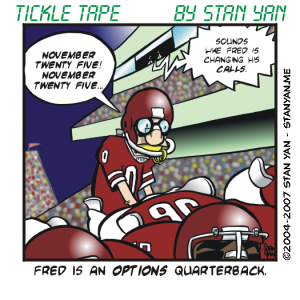A common belief among novice traders is that one always needs to be right. Many believe that a trading strategy must always produce a profit. Although it is true that a long losing streak can wipe out one’s trading account, one can actually have a large proportion of losing trades to winning trades and still be profitable. It’s merely a matter of using risk management. Let’s consider a specific hypothetical example to illustrate this point.
Suppose John has $150,000 to invest. He decides to arbitrarily risk 3% of his capital on each of 10 trades. He figures it is a relatively small amount that he could afford to risk and lose. He also decides to use a simple stop-loss rule: if a stock price drops below 8% of the purchase price, then sell. He then uses an arbitrary sell rule for his winning trades: If a stock increases by 20% of the purchase price, then sell. (Please note that we aren’t advocating the use of these rules, we are just trying to make a point).
Let’s calculate the expected results. Approximately $4,500 is risked on each trade. If the trade loses $360, it is sold. If the trade produces a $900 profit, it is sold. If 3 out of 10 trades are winners, the overall profit (wins – losses) is (3 X $900) – (7 X $360) = $2700 – 2,520 = $180. Now, $180 isn’t very much of an overall return, but you can see the point. Even by winning only 3 out of 10 trades, there is still a profit. (It’s necessary, however, to use a discount interactive broker who charges less than $5 for a round-trip trade).
This is quite a conservative strategy. One probably wouldn’t want to follow it precisely. It demonstrates, however, that one doesn’t always need to be right all the time to come out ahead. Nevertheless, you may see that a few modifications can make the general approach very profitable. For example, if one were to win 50% of the trades, the expected profit is (5 X $900) – (5 X $360) = $4,500 – $1,800 = $2,700. Similarly, one probably would not want to sell a winning trade merely because it reached a 20% profit. One can “let it ride a little longer” and perhaps make a 50% profit, for example. This would result in even more profits. The incorporation of risk management rules allows you to be wrong a lot of the time, and it is reassuring to remember this point.
So remember that you don’t always have to be right to make a profit overall. Even by using a very simple set of risk management rules, and following them mechanically, you can come out ahead. The lesson is not to use such rules mechanically, but to consider how some simple planning and risk management can prevent emotions, such as anxiety and fear, from negatively impacting your trading decisions.
When you are first learning to trade, risk management can help you survive, stay in the game, and allow you to hone your trading skills. As you gain more skills, you can risk a little bit more on trades you have identified as “high probability setups” and fine-tune your stop-loss or exit rules. But in the meantime, consider keeping your goals modest, with the main goal of minimizing risks, building skills, raising self-confidence, and refining your method.


